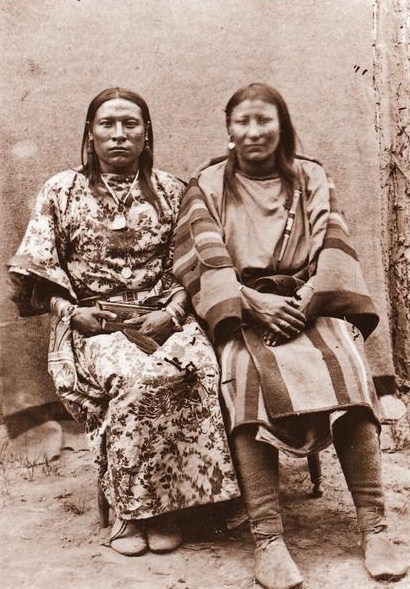Osh-Tisch
Osh-Tisch, a Crow two-spirit person with long dark hair. She sits with a Crow woman.
“Did the men ever tell you anything about a woman who fought… on the Rosebud?”
– Pretty Shield
A warrior, artist, and incredibly valued person in the Crow nation, Osh-Tisch was baté. She is remembered as one of the last baté people to have existed before colonizers committed genocide against this part of Crow culture. A baté person is a person who is born with a body that many European cultures of the time designated as male, and later is discovered to be a woman and is accepted as a woman in Crow culture.
Osh-Tisch was a leading baté of the Crow nation and held an esteemed position in her society. In the Crow nation, it was not only acceptable for one to be baté, but they were often regarded highly as being the bridge between the two genders. Being baté, Osh-Tisch was allowed to take on traditionally female and traditionally male roles and excelled at both. She was esteemed not only for her amazing sewing skills, which earned her the right to make the Crow Chief Iron Bull’s a buffalo skin lodge, but she was also known for her ferocity in battle. Her strength as a warrior is what earned her the name Osh-Tisch, which translates to “finds them and kills them.” Not only incredibly threatening and impressive, but it also refers to the time she helped another soldier by shooting a wounded enemy in the Battle of Rosebud.
Osh-Tisch, with her community accepting her, flourished. However, it did not last. In the late 1890s, a federal agent came onto Crow territory, sent to enforce European values.
At that time, most of Europe was not the safest place for queer people. The overwhelming majority of people were at best ignorant of queer issues, and at worst genocidal towards the queer community. Much of this attitude came from the religious teachings at the time, which were then brought over to what is now called America.
During their invasion, European colonizers imposed not only their bigoted beliefs but their understandings of gender and sexuality. At the time much of Europe was convinced of a strict binary model of both gender and sex, which has since been proved unscientific and largely baseless. It was this fundamentally flawed model that they attempted to force upon the Crow people.
When colonizers came across the baté, they didn’t react well and tried to “fix” the “problem.” Missionaries were often sent to rehabilitate these people and force them into a gender that they weren’t and into gender roles that were wholly European. In this case, it was not a missionary but a federal agent.
Federal Agent Briskow came into Crow land, gathered as many baté as he could, and forced them to do as he wanted. He made them get masculine European haircuts, and dress as European men would, forcing them into manual labour.
It is important to explicitly note here that it was European gender roles he was forcing them into; Osh-Tisch did manual labour before. Just because she was not a man does not mean she did not experience what most Europeans considered masculine. This includes fighting in a battle, something that was considered masculine by many European societies. Not only were they stripping her gender away, but they were also stripping away her culture.
But her community stood behind her. Though the Crow people often didn’t have much influence, Chief Pretty Eagle managed to force the agent into resignation and made him leave their land. The Crow nation stood behind the baté and defended them passionately. Horrified by the notion that this agent would force the baté to become something they were not. They called it “unnatural”.
Unfortunately, that is not the end of the story. While during her life Osh-Tisch did her best to support the baté, after her death, the European societal norms all but took over, and Osh-Tisch was known as one of the last baté for a long time.
Fortunately, that also isn’t the end of the story, either. Despite how hard people have tried to wipe out this part of history, the story has not ended. It is here, and Indigenous communities preserve it. Though the Europeans did manage to take over America and destroy much of Indigenous culture, there are still people working today to uncover and reconnect to it.
Like every part of history, knowing that something has happened before tells us it can happen again; in this case, that statement isn’t a warning; it is a message of hope.
REFERENCES AND FURTHER READING
Disclaimer: some of the sources may contain triggering material
From ‘100 Voices’ – Pretty Shield’s Story of the Battle of the Little Bighorn. (n.d.). Retrieved May 23, 2023, from https://astonisher.com/pretty-shields-story-of-the-battle/
Historical Two Spirits. (n.d.). Retrieved May 23, 2023, from https://web.archive.org/web/20160324191211/http://nativeout.com/twospirit-rc/two-spirit-101/historical-two-spirits/
Roscoe, W., & Gay American Indians (Organization). (n.d.). Living the spirit: A gay American Indian anthology. New York.
Sophia Seaberg-Wood. (2015, July 17). “Not a Man, Not a Woman” · Global Indigenous Struggles Since 1900 · History Corps. https://web.archive.org/web/20150717042420/http://dsph-dev.provost.uiowa.edu/historycorps_sandbox/exhibits/show/indigenousstruggles1900/bote




